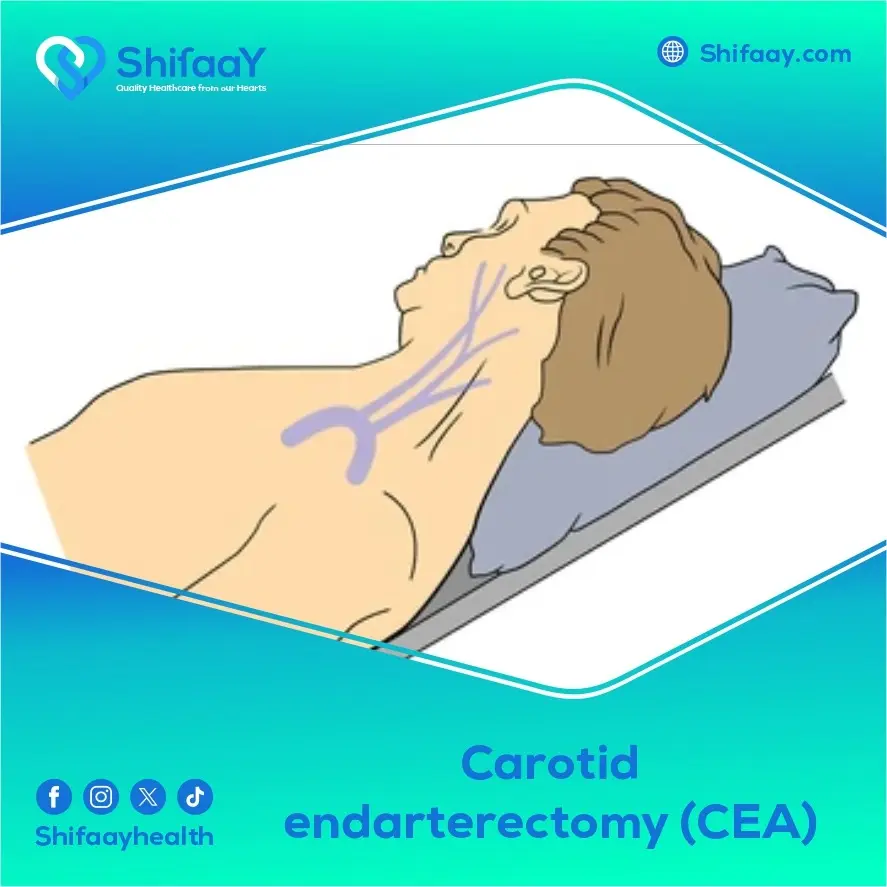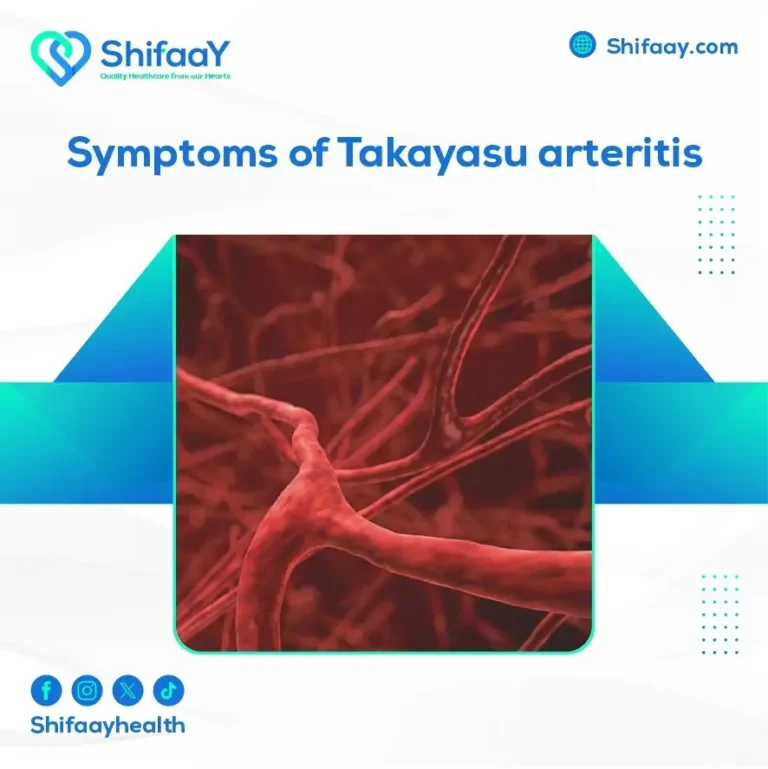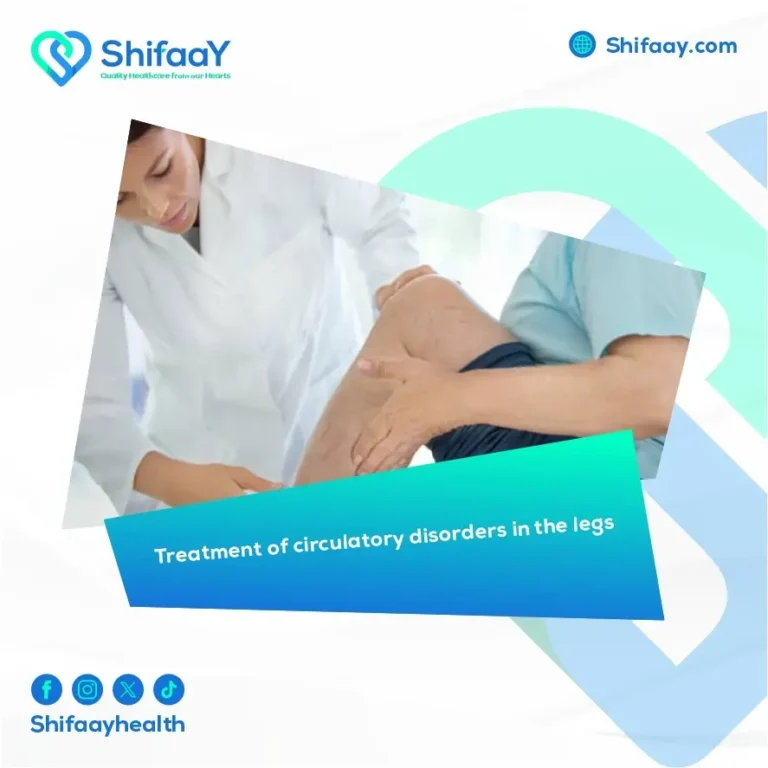What is Carotid Endarterectomy?
Carotid Endarterectomy (CEA) is one of the essential medical procedures that helps save many lives, especially for those suffering from carotid artery stenosis, which is one of the main arteries responsible for supplying the brain with oxygenated blood. When fatty deposits (plaques) accumulate on the walls of this artery, it can cause severe narrowing of the blood flow, increasing the risk of a stroke or transient ischemic attacks. Hence, surgical intervention becomes crucial as an effective solution that restores normal blood flow and prevents potential complications. During this surgery, the specialist carefully removes the accumulated fatty deposits from the artery, allowing the blood vessel to expand and improving brain perfusion.
Shifaay Health Center is one of the leading specialized medical centers that pays exceptional attention to Carotid Endarterectomy (CEA) surgery due to its pivotal role in preventing strokes and maintaining brain health. This center strives to offer comprehensive medical services that typically include precise diagnostics using the latest medical imaging technologies, determining the degree of artery stenosis accurately, and then making the most suitable treatment decision for each case based on well-studied scientific criteria. The center also ensures that this type of surgery is performed by a leading team of vascular surgeons with extensive experience in handling delicate and complex cases, using the latest medical equipment and technologies to ensure patient comfort, speedy recovery, and providing thorough post-operative follow-up to minimize any future complications and enhance full recovery chances.
Carotid Endarterectomy (CEA) surgery is typically performed in cases where tests show significant artery narrowing. It is often recommended for patients who have experienced transient ischemic attacks or mild strokes, as they are at a higher risk of future strokes compared to others. Before undergoing this type of surgery, the patient undergoes a thorough evaluation that includes medical history, blood tests, and advanced imaging exams such as ultrasound, CT scans, or MRI to accurately determine the extent of the blockage. This helps the medical team develop a customized treatment plan tailored to each patient’s condition. Once the need for surgery is confirmed, the patient is carefully prepared according to established safety protocols, including managing risk factors such as blood pressure, cholesterol levels, and controlling diabetes if present.
Carotid Endarterectomy (CEA)

Carotid endarterectomy may be the ideal decision that saves you from the risk of a sudden stroke, which can change the course of your life within a matter of seconds. This medical procedure is one of the effective surgical solutions that significantly helps remove fatty deposits and plaques that obstruct blood flow to the brain, often leading to artery blockage or serving as a source for the formation of small blood clots that travel to the brain, causing a stroke.
With the advancement of medical technologies, carotid endarterectomy (CEA) surgery has become safer and more effective than ever, especially with the relatively short recovery period compared to other surgeries. The patient can regain daily activities quickly and return to their normal life in a short period. This surgery can also significantly reduce the risk of recurrent strokes and improve quality of life by restoring normal blood flow to the brain and preventing the formation of clots. Furthermore, it represents a reliable option for patients with severe carotid artery stenosis or those who have experienced transient ischemic attacks (TIAs).
Therefore, if you experience warning symptoms such as weakness on one side of the body, difficulty speaking, sudden dizziness, or even temporary loss of vision, it may be necessary to seek the services of Shifaay Health Center. The center includes a leading team of vascular disease specialists and experts in carotid endarterectomy, alongside the latest diagnostic and therapeutic technologies, to ensure comprehensive and safe medical care. It will assess your condition accurately and develop the most appropriate treatment plan, whether through close monitoring or surgical intervention if necessary. This contributes to reducing the risks of serious complications and preserving your health and life.
Read aslo: What is the Gastric Balloon Procedure?
Symptoms of Carotid Artery Blockage in the Neck
It is important to note that the symptoms of carotid artery blockage in the neck may be silent at first, but they can pose a real threat to life, especially as people age or have risk factors such as smoking, high blood pressure, and high cholesterol. This condition may develop silently until serious complications such as stroke or transient ischemic attack (TIA) occur, which could be the first sign of carotid artery blockage.
Many people are unaware of the dangers of fatty deposits accumulating within the carotid artery, as neglecting them can often lead to sudden blockage due to poor brain perfusion, which threatens the lives of many. Therefore, early detection of any potential symptoms is a critical step in preventing strokes, which are among the most common complications of blockage in this vital artery. Here are the main symptoms that may indicate a blockage in the carotid artery:
- Sudden weakness or numbness in the face or limbs, especially on one side of the body.
- Difficulty speaking or understanding speech, which may appear for a few minutes and then disappear.
- Vision problems, such as temporary loss of vision in one eye or blurred vision.
- Dizziness or loss of balance, which may be accompanied by a general feeling of confusion or difficulty moving.
- Sudden, severe headache, which may be accompanied by other neurological symptoms.
- A sensation of heaviness in the neck or an abnormal pulse when touching the neck.
It is crucial not to ignore any symptoms of carotid artery blockage in the neck, even if they disappear after a few minutes, as this could be a sign of a transient ischemic attack, which is an early warning that could precede a stroke. Therefore, it is recommended to consult a specialist at Shifaay Health Center immediately upon noticing any of these symptoms to receive an accurate diagnosis and appropriate treatment before the condition worsens.
Carotid Artery Stenosis Treatment
The treatment of carotid artery stenosis is a health topic that affects many individuals due to the direct risk it poses to blood flow to the brain and the potential for stroke. Therefore, if you are looking for precise and reliable information about the latest medical methods for treating such conditions, Shifaay Healthcare Center offers everything you need, including consultations and advanced procedures aimed at improving blood flow and ensuring the health of the heart and brain. Below is a list of advanced treatments tailored to each case based on the degree of stenosis and the overall health of the patient:
First, Medication
Medication is used to control risk factors such as high blood pressure and cholesterol, and typically includes blood-thinning drugs such as aspirin.
Second, Carotid Artery Angioplasty and Stenting
This is a relatively non-invasive procedure in which a thin tube is inserted through a blood vessel to place a stent that helps widen the artery and improve blood flow.
Third, Carotid Endarterectomy (CEA)
This is a medical procedure in which fatty deposits are removed from the artery wall, directly widening the blood flow.
Finally, Lifestyle Changes
This includes quitting smoking, following a healthy diet, and engaging in regular exercise.
Comparison Between Carotid Endarterectomy and Stenting
The comparison between Carotid Endarterectomy (CEA) and stenting is undoubtedly one of the common medical topics that many people interested in the best treatment method for artery diseases pay attention to. This is especially true given the variety of treatment options and the different health conditions of each patient. Therefore, if you suffer from arterial blockage and are confused about whether to choose the surgical procedure of endarterectomy or the less invasive stent procedure, below are the differences between the two methods and their roles in improving quality of life.
First, Carotid Endarterectomy:
This is a surgical procedure aimed at removing the fatty deposits accumulated inside the artery, which may hinder normal blood flow. This procedure is usually used to treat the carotid artery in the neck, which supplies blood to the brain, in order to reduce the risk of stroke.
Carotid Endarterectomy is one of the most effective medical solutions in advanced cases where medications or minor interventions fail. It is performed under careful medical supervision and usually requires local or general anesthesia. Additionally, the patient may need a short recovery period in the hospital afterward, along with regular follow-up to ensure the success of the procedure and prevent recurrence of blockage.
Second, Stenting:
This is one of the less invasive treatment options for carotid artery blockage, where a small tube called a “stent” is used to open the narrowed or blocked arteries. The stent is inserted through a catheter without the need for a large surgical incision.
This procedure is suitable for patients who cannot undergo surgery or in cases where the blockage is moderate. It also typically offers faster recovery and fewer complications compared to surgery. Furthermore, it is highly effective if selected for appropriate cases with good medical follow-up.
Carotid Endarterectomy (CEA) Success Rate
There is no doubt that Carotid Endarterectomy (CEA) is one of the vital medical procedures typically performed to prevent strokes and improve blood flow to the brain. Some medical statistics show that the success rate of such operations always exceeds 96%. However, this rate can vary from case to case based on several important factors, such as:
First, the surgeon’s experience and skill: The more experienced the surgeon is in performing this type of surgery, the higher the chances of success and the lower the risk of complications.
Second, age: The patient’s age plays a significant role in determining the success rate of the carotid surgery, with younger patients generally having a higher success rate compared to older patients.
Third, general health: Chronic conditions like diabetes, high blood pressure, or heart disease can negatively affect the surgery’s outcomes.
Fourth, the degree of artery blockage: The extent of carotid artery blockage can have a direct impact on the complexity of the surgery and its chances of success.
For this reason, it is always recommended to have the carotid artery surgery performed by a specialist in the field, preferably one with extensive experience in microvascular catheterization. Among the prominent names in this field is the physician affiliated with Shifaay Center, who is renowned for a successful track record in performing carotid artery catheterization with precision and high efficiency.
Carotid Endarterectomy (CEA) Cost
The cost of Carotid Endarterectomy (CEA) is one of the most common questions that many patients suffering from carotid artery stenosis or blockage ask. This condition is serious and could lead to severe complications, such as a stroke, if not treated promptly. Therefore, this surgery is considered a precise procedure aimed at removing fatty deposits from the carotid artery in the neck to improve blood flow to the brain. Since it is performed in a very sensitive area, the cost is not only related to the surgical procedure itself but also includes medical care, the surgeon’s expertise, the techniques used, and the duration of the hospital stay.
The cost determination for the carotid surgery depends on several key factors, including the hospital or medical center’s location, available equipment, and the type of anesthesia used. Additionally, pre-surgery tests and post-operative care are also factored in. Prices may vary significantly between the public and private sectors, with some patients finding more affordable treatment options in public hospitals or through health support initiatives. In contrast, private hospitals and medical centers offer more specialized services and quicker appointment scheduling at a higher cost. Therefore, understanding the detailed breakdown of what the cost includes is essential to avoid financial surprises.
It is highly advisable for any patient or their caregivers to contact Shifaay Healthcare Center, the best medical tourism company in Egypt, in advance to obtain an accurate cost estimate, whether out-of-pocket or covered by health insurance. Since this procedure directly impacts brain and heart health, delaying it due to unclear costs could have severe consequences. Therefore, it is recommended to contact the center promptly to avoid serious complications.
The Difference Between Endarterectomy and Angioplasty

The difference between Carotid Endarterectomy and Angioplasty is one of the most important topics for patients suffering from arterial problems and arteriosclerosis, especially when searching for the best treatment option for their condition. With the increasing prevalence of cardiovascular diseases, it has become essential to understand the precise differences between these procedures, not only in terms of the techniques used but also regarding effectiveness, recovery period, and the safety of each procedure based on the patient’s overall health condition. While a surgeon may recommend a full surgical procedure like endarterectomy, in other cases, angioplasty may be the best option to reduce complications and speed up recovery. Understanding these differences allows the patient to be an active part of the treatment decision, approaching their condition with confidence and peace of mind based on a true understanding of each option.
Carotid Endarterectomy is a traditional surgical procedure in which fatty deposits are manually removed from the artery walls, usually performed in the carotid artery in the neck or other large arteries. It is typically done under general or local anesthesia and is preferred in cases of severe narrowing or when the deposits are large and rigid.
This procedure directly restores blood flow and reduces the risk of stroke or clot formation. It is suitable for patients who can tolerate surgery.
On the other hand, Angioplasty is a less invasive procedure where a catheter is inserted into the artery, and the narrowed portion is expanded using a balloon, with a stent (mesh tube) often placed to keep the artery open.
Angioplasty is performed under local anesthesia and is commonly used in peripheral arteries or coronary arteries. It is an ideal choice for patients who cannot undergo surgery or those who wish for a quicker recovery.
What is Carotid Endarterectomy?
Carotid Endarterectomy is a surgical procedure in which fatty deposits and plaque are removed from the carotid artery to improve blood flow to the brain and prevent strokes.
What Are the Risks of Carotid Endarterectomy?
The risks of Carotid Endarterectomy include stroke, bleeding, infection, nerve damage, or re-narrowing of the artery. The risks increase in elderly patients or those with heart disease.
How Long Does Carotid Endarterectomy Take?
Carotid Endarterectomy typically takes one to two hours but may take longer depending on the patient’s condition and the complexity of the blockage in the artery and blood vessels.






